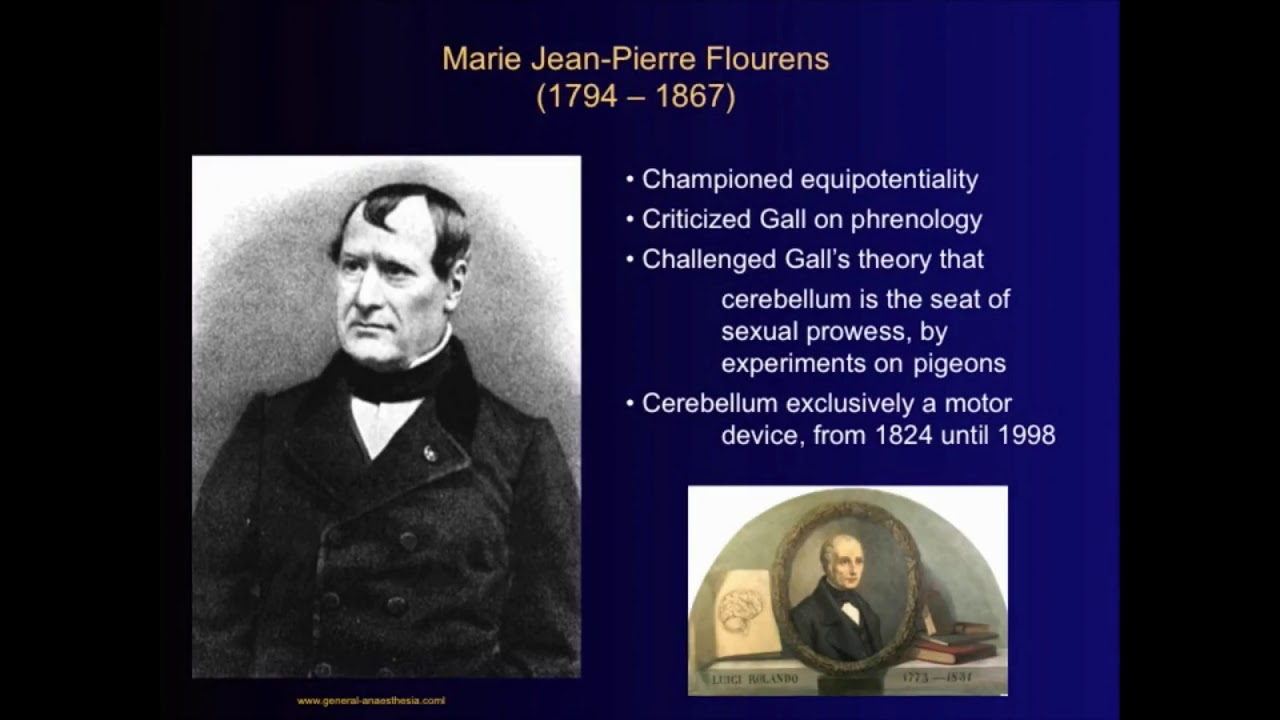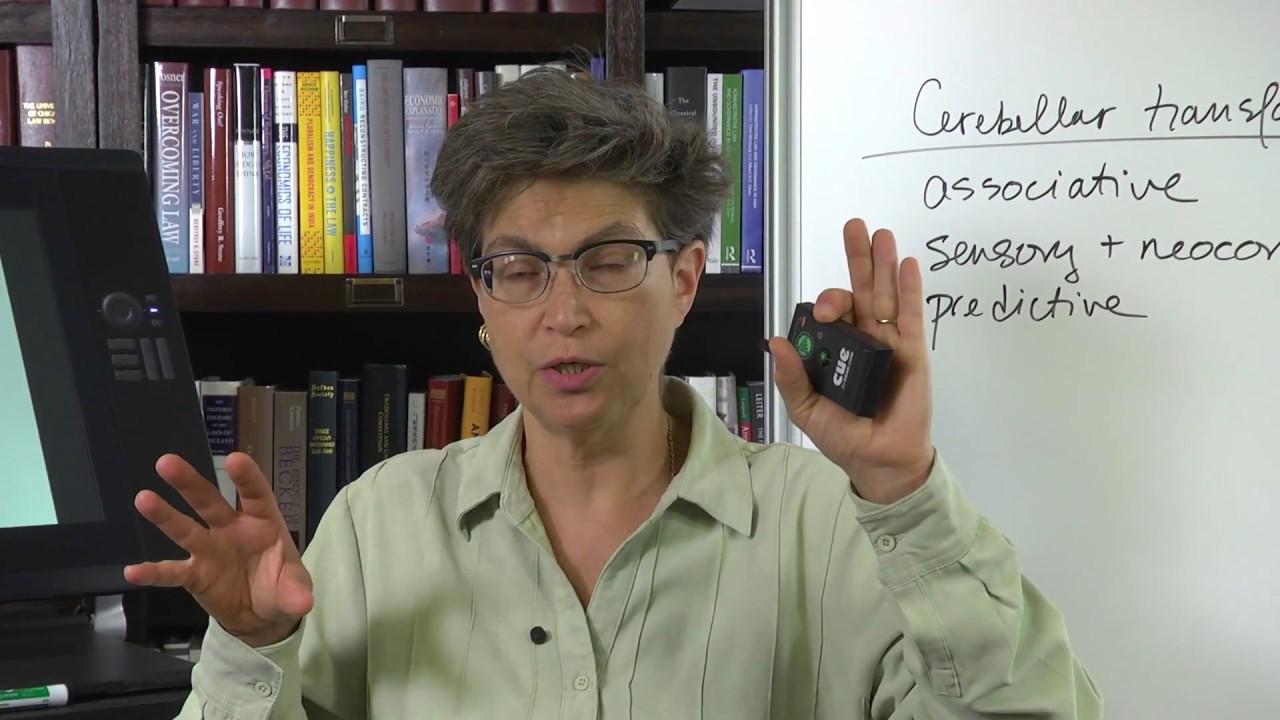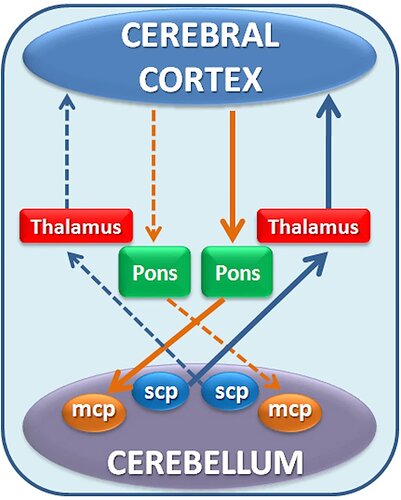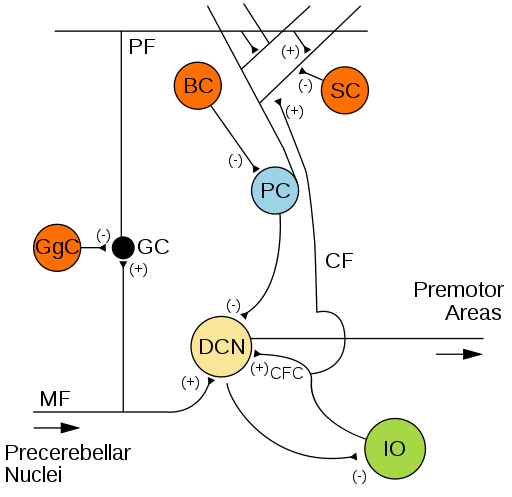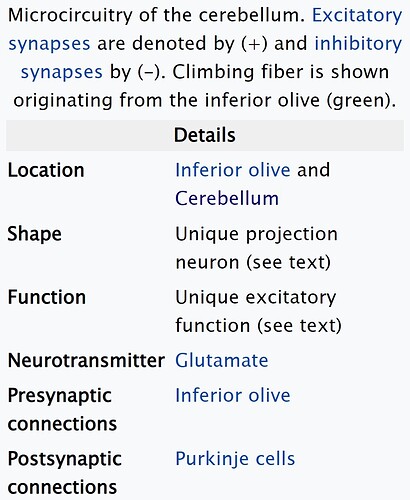According to the long-established view, the cerebellum controls motor functions. Although it occupies only about 10% of brain volume,
the cerebellum contains around 50 % of all neurons in our brain. It has several functions. The most important ones include balance, motoric activities, walking, standing, and coordination of voluntary movements. It also coordinates muscular activity and speech.
It also coordinates eye movements, thus heavily impacting our vision. [The c]erebellum also takes part in activities such as riding a bicycle, dancing, various sports, and playing a musical instrument.
Most importantly, the cerebellum is responsible for receiving signals from other parts of the brain, the spinal cord, and senses. Therefore, damage to this part of our brain often leads to tremors, speech problems, lack of balance, lack of movement coordination, and slow movements.
In film clips at the beginning of this keynote presentation we see awkward gait, difficulty controlling relationships between extremities and other points (sliding heel up shin, moving finger between nose tip and a distal point), and also speech difficulties.
Then fMRI studies opened neuroscientists’ eyes to broader functionality.
The big surprise from functional imaging was that when you do these language tasks and spatial tasks and thinking tasks, lo and behold the cerebellum lit up.
Traditionally, most neuroscientists have considered the cerebellum (Latin for “Little Brain”) to have the relatively simple job of overseeing muscle coordination and balance. However, new findings show that the cerebellum is probably responsible for much, much more including the fine-tuning of our deepest thoughts and emotions.
What are these more abstract non-motor functions of the cerebellum and how are they related to the motor functions of the cerebellum? We may be able to make some inferences from comparative anatomy.
Certain bats, toothed whales (not limited to orcas), and most of all elephants have a proportionally larger cerebellum as compared to other animals.
https://anatomypubs.onlinelibrary.wiley.com/doi/full/10.1002/ar.22425
These animals depend upon echolocation in a fluid environment, a sensory domain in which the means and processes for constructing relationship and transition perceptions such as relative distances and velocities in a complex environment are probably considerably more complex than in the visual modality. In common with humans, they are also highly social animals. This is well known for cetecians, but only in recent research
bat social systems are emerging as far more complex than had been imagined. Variable dispersal patterns, complex olfactory and acoustic communication, flexible context-related interactions, striking cooperative behaviors, and cryptic colony structures in the form of fission-fusion systems have been documented.
However, humans and our immediate great ape cousins are distinguished from our more distant evolutionary cousins by the ratio of the size of the cerebellum relative to the cerebrum.
The cerebellum expanded rapidly in parallel lineages of apes, including humans … increas[ing] in absolute size and relative to neocortex size. This expansion began at the origin of apes but accelerated in the great ape clade. Cerebellar expansion may have been critical for technical intelligence."
https://www.sciencedirect.com/science/article/pii/S0960982214010690
Frans Plooij has told me that there is further differentiation between humans and our primate cousins, so that in humans the volume of the cerebellum has increased relative to the volume of the cerebrum even more than in apes. It appears that more of the same kinds of neural systems were added. They were added in the same place, forming a new posterior lobe of the cerebellum.
The interconnections between the cerebellum and cerebrum are described as imposing a partition of cortical systems into functionally distinct areas, but I’m not sure the arrow of causation implied by “confer” in the following passage is warranted:
Cerebrocerebellar connections confer functional topography on cerebellar organization." [That is, functionally distinct areas of the cerebrum correspond to groups of perceptual control structures in the cerebellum. --BN] Sensorimotor processing is represented principally in the cerebellar anterior lobe. Anterior lobe damage causes the motor syndrome of gait ataxia and limb dysmetria. Cognition and emotion are subserved by the cerebellar posterior lobe. Posterior lobe lesions cause the cerebellar cognitive affective syndrome (CCAS)" and what is called dysmetria of thought and emotion.
https://www.sciencedirect.com/science/article/abs/pii/S0304394018304671
Almost all of the neocortex projects into the cerebellum.
These guys and gals are still stuck in the computational metaphor that is at the foundation of CogSci and CogPsych, talking of a ‘cerebellar transform function’ being like a ‘chip’ that performs information-processing functions as the brain creates a symbolic representation of the world, does ‘information processing’ on that representation, and issues commands through the motor functions, but nonetheless it is possible to glean some useful information. The idea of diaschisis revived by Sam Wang (discussed in the above video) suggests that in the developmental process growing proficiency in motor control provides support for subsequent growing proficiency in more abstract conceptual control. Notice on the whiteboard behind her the word “Associative” among the functional properties of the so-called “cerebellar transfer function”. A striking assertion in the discussion of diaschisis links neonatal cerebellar damage to later autism, because the developing brain lacks this ‘service’ of the cerebellum. It would be of value to know if failure to develop the posterior lobe is a characteristic, and, if this is so in some but not all cases of autism, what clinical distinctions might accompany this anatomical difference.
She refers to a recent case of a 24-year-old woman with no cerebellum.
the fact that she has made it this far is a testament to the plasticity of the brain.
No kidding! Reorganization is very powerful, but it starts with what is given. The cerebrum apparently cannot develop on its own the multitude of connections that are genetically determined in development of the cerebellum and pons. And if neuroscience conjectures (above) are correct about the cerebellum supporting development of cognitive skills with analogs to motor skills, the basis upon which reorganization in the cerebrum starts has developmental deficiencies.
Schmahmann is a big name here, and he articulates what may be the dominant revised view that the cerebellum provides a kind of smoothing function in the supposed information-processing machinery.
Research on … people [lacking a cerebellum] supports the idea that the cerebellum really has just one job: It takes clumsy actions or functions and makes them more refined. “It doesn’t make things. It makes things better,” Schmahmann says.
That’s pretty straightforward when it comes to movement. The brain’s motor cortex tells your legs to start walking. The cerebellum keeps your stride smooth and steady and balanced.
“What we now understand is what that cerebellum is doing to movement, it’s also doing to intellect and personality and emotional processing,” Schmahmann says.
Unless you don’t have a cerebellum. Then, Schmahmann says, a person’s thinking and emotions can become as clumsy as their movements.
[This quotation is from the NPR transcript linked above.]
From these and other observations, I infer that systems in the cerebellum control Configuration, Transition, and Relationship perceptions–an empirical proposition that is amenable to test. Transition control is about smooth changes in relationships and configurations. Without good control of Transitions, or without good control of the relationships and configurations that are changing or being changed, dysmetria results.
I believe that these are all closely similar in structure and function, differing in the perceptions that their input functions assemble and the reference values that their error signals adjust. That is, there is every reason to suppose that expansion of the cerebellum creating its posterior lobe was accomplished by replicating control structures of the same kind that have served more ‘concrete’ purposes in the older anterior lobe of the cerebellum. This is what I mean when I say that systems originally created for ‘concrete’ control of environmentally perceived configurations, relationships, and their transitions, etc. are ‘repurposed’ for control of configurations and relationships among ‘abstract’ concepts, and their transitions, etc. Introspection on subjective visual and kinesthetic correlates of thinking processes is consistent with this, as also e.g. subjective visual and kinesthetic correlates of the configurations, relationships, and transitions perceived while listening to a Bach trio sonata. This is what I mean when I say that structures developed in the anterior lobe of the cerebellum by evolution and learning for controlling ‘concrete’ configurations, relationships, and transitions are ‘repurposed’ in the posterior lobe for controlling more ‘abstract’ configurations, relationships, and transitions. Some of the quoted testimony of neuroscientists suggests that control of the former sort provides some kind of guidance or template for learning control of the latter sort. If that process can be demonstrated more explicitly, it would be a good candidate for the verb “repurposing”.
Importantly, the cerebellum has many projections into the limbic system and is seen as integrating affect with cognitive processing. I initiated a topic about the creation of emotion perceptions from perceptions in the somal branch of the hierarchy in the Emotion category.
Orders of perception above Configuration, Transition, and Relationship perceptions are essentially different. Sequence perceptions (and well-skilled, short Event perceptions) require temporal separation of input perceptions, and Planning involves control of alternative sequences in imagination. (Talk of Programs enmeshes us in the misleading computational metaphor. But that is another topic.)
